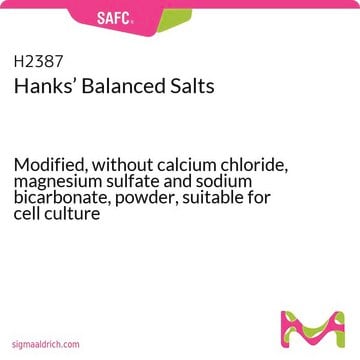H9394
Hanks′ Balanced Salt solution
Modified, with sodium bicarbonate, without calcium chloride and magnesium sulfate, liquid, sterile-filtered, suitable for cell culture
Synonym(s):
HBSS
About This Item
Recommended Products
sterility
sterile-filtered
form
liquid
technique(s)
cell culture | mammalian: suitable
impurities
endotoxin, tested
components
NaHCO3: 0.35 g/L
glucose: 1.0 g/L (Dextro)
phenol red: 0.011 g/L
shipped in
ambient
Looking for similar products? Visit Product Comparison Guide
Related Categories
General description
Application
- as a component of the culture medium for culturing of mouse cortical slices
- as a component of the dissociation buffer for incubation of human-induced pluripotent stem cells (hiPSCs) and hiPSC-derived cardiomyocytes (CMs)
- for in situ perfusions of mice liver
Biochem/physiol Actions
Storage Class Code
12 - Non Combustible Liquids
WGK
WGK 1
Flash Point(F)
Not applicable
Flash Point(C)
Not applicable
Certificates of Analysis (COA)
Search for Certificates of Analysis (COA) by entering the products Lot/Batch Number. Lot and Batch Numbers can be found on a product’s label following the words ‘Lot’ or ‘Batch’.
Already Own This Product?
Find documentation for the products that you have recently purchased in the Document Library.
Customers Also Viewed
Protocols
StableCell™ Trypsin solutions are designed to perform cell detachment as standard trypsin solutions do, without the need to aliquot, freeze, and thaw. This saves significant time before passaging.
Trypsin is commonly used for dissociating adherent cells from surfaces. A wide variety of trypsin solutions are available to meet your specific cell line requirements.
Trypsin is commonly used for dissociating adherent cells from surfaces. A wide variety of trypsin solutions are available to meet your specific cell line requirements.
Trypsin is commonly used for dissociating adherent cells from surfaces. A wide variety of trypsin solutions are available to meet your specific cell line requirements.
Our team of scientists has experience in all areas of research including Life Science, Material Science, Chemical Synthesis, Chromatography, Analytical and many others.
Contact Technical Service







